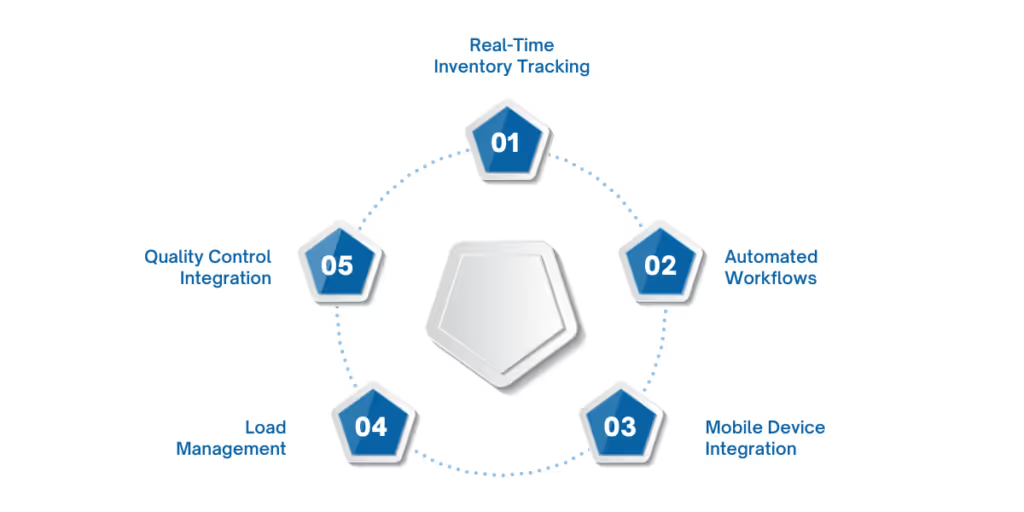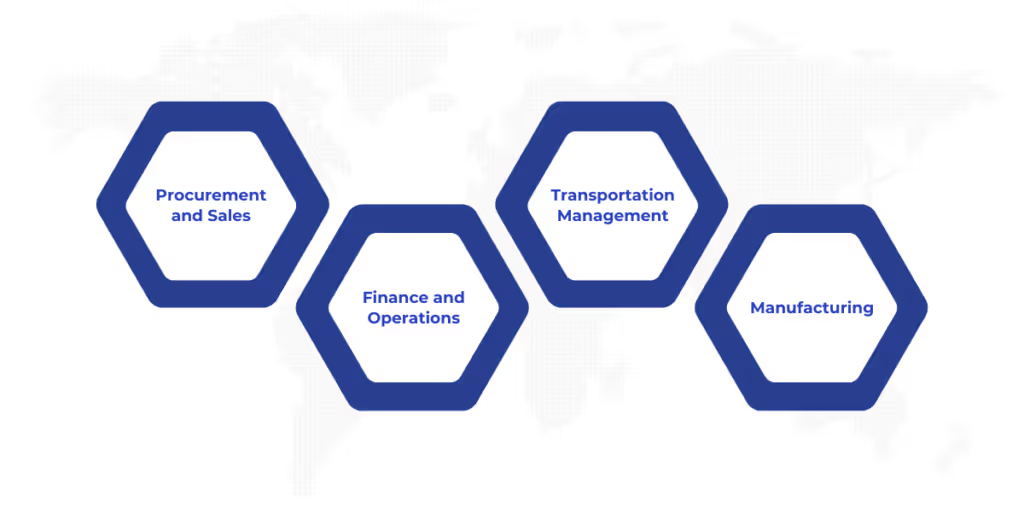

Warehouse management is central to your supply chain.
We live in an era when speed, accuracy, and efficiency define your notion of success. Advanced Warehouse Management for Dynamics 365 is an easy answer to the challenge. It is the comprehensive set of warehouse-focused business processes built right within Dynamics 365 Supply Chain Management that can help you optimize and automate your warehousing processes.
In this blog, we will explain what this module is, its key functionalities, the value it provides to your business, and where it fits within your other supply chain functions. We’ll also talk about potential issues you may encounter during implementation and some high-level best practices to ensure your success. When you are finished with this blog, you will be able to see how this tool can complement your warehouse operations.
Advanced Warehouse Management in Dynamics 365 is a module used by organizations that have moved to automated and sophisticated warehousing operations. It can be found in Dynamics 365 Supply Chain Management, and it provides tools to track the basic inventory items to complex material handling processes that occur in warehouses today.
You will find it applicable to warehouses of any size, whether it be a single warehouse or a network of distribution centers. It also facilitates inbound and outbound workflows, which allows multiple processing to occur with items from the time of receipt to the time of shipment.
This module’s core purpose is to provide visibility and control to your warehouse operations. There are numerous advanced scenarios in the official documentation provided by Microsoft, such as multi-order picking, mixed license plate receiving, and full join between all of your transportation and manufacturing functionalities. From the standpoint of an organization using Advanced Warehouse Management, it provides real-time data and visibility into inventories, the productivity of workers, and the efficiency of processes.
To take this a step further, if you are running a high-volume warehouse, Advanced Warehouse Management will allow you to answer where each item resides at each moment and the status of each, which is very reliable and eliminates guesswork and delays. There is much more to Advanced Warehouse Management than being just aware of inventory; visibility enables you to make better decisions with evidence and room to adapt.

Dynamics 365 WMS comes packed with features designed to tackle the complexities of modern warehouse operations. Let’s break down the most important ones.
One of the most important features of Dynamics 365 WMS is real-time inventory tracking. No matter if you’re receiving shipments or fulfilling orders, the system updates inventory in real-time so that everyone has the latest data without guesswork. There is no need to question how much stock you have left or worry about stock amounts on the floor and in your system being slightly off.
Efficiency is everything in a warehouse. Dynamics 365 can automate major operational processes (e.g., picking orders, packing orders, and restocking inventory). It can automatically create work tasks based on templates, saving the need to manually input work and getting people to do things quickly and correctly. With automation, employees can also redirect their focus to quality or customer service tasks.
In our current world, mobile technology is unavoidable. Dynamics 365 WMS fits perfectly with mobile devices so that warehouse workers can store, scan barcodes, update inventory, and receive complete, real-time notifications directly from their mobile device. Therefore, staff can easily complete workflows that are on the move as the change happens and will make further battery exist by keeping data up to date.
Handling multiple orders can be unmanageable, particularly if you receive high volumes. That is where wave management comes in handy. It lets you bundle orders into waves according to certain criteria (e.g., shipping priority, delivery route), maximizing your warehouse's resources. It ensures that your team pulls the correct products in the correct order, enhancing speed as well as accuracy.
Keeping product quality at its best is a high priority for any warehouse operation. Dynamics 365 WMS brings quality control directly into your business processes. That's how you define quality rules, perform inspections during receiving or shipping, and only allow the best-quality goods to leave your warehouse. By identifying issues early, you minimize returns and enhance customer satisfaction.
With these features in place, your warehouse becomes not just a storage space but a highly efficient, well-oiled machine that keeps your supply chain running smoothly. But let’s move on to discuss the benefits of using Dynamics 365 WMS.
Now that you know what Dynamics 365 WMS can do, it’s time to explore the benefits it can bring to your business. From cost savings to better customer experiences, here’s how this system makes a difference:
Automating everyday tasks and improving visibility throughout your organization significantly reduces the time spent completing tasks. By taking advantage of real-time data updates and automated workflows, your team can work faster, fully engaging their focus on work rather than time and process. More speed means more throughput, fewer delays, and faster order fulfillment.
Along with real-time inventory data, there are now add-on mobile integrations for devices that ensure your team is always operating from current, updated data. This increases accuracy, lessens errors (by limiting human interaction), minimizes overstocking and stocking out items, and ensures that every order is supplied correctly and optimally. Accuracy isn't negotiable when it comes to customer satisfaction; it is imperative to ensure an accurate customer experience while utilizing Dynamics 365.
Cost cuts are easier to achieve when your warehouse is running smoothly, thanks to better visibility and efficiency. Automation will help reduce labor costs by not relying on manual intervention as staff operate on complete automation tasks and inventory. Never over, never under-stock, sub-locations and stock discrepancies are automated in real-time to reduce unnecessary expenditure on inventory, storage, and movement.
As your business grows, so do your warehousing needs. Dynamics 365 is built to scale with your company, whether you’re managing one warehouse or expanding to multiple locations. The system can easily handle increasing volumes, allowing you to keep pace with growth without compromising on performance.
In the end, it all comes down to delivering a better experience for your customers. With faster and more accurate order fulfillment, timely deliveries, and reduced errors, you can ensure that customers receive their orders exactly as expected. When your warehouse runs smoothly, so does your customer satisfaction.
Visit the official Microsoft documentation for more information.
Now that we've covered the benefits, let’s look at how Dynamics 365 integrates with other supply chain functions to provide a complete, streamlined solution.

One of the reasons Dynamics 365 WMS stands out is its ability to integrate with other parts of your business. This isn’t just a standalone tool—it’s part of a larger ecosystem that ensures your entire supply chain operates in harmony.
By connecting all these functions, Dynamics 365 helps ensure that your entire supply chain operates smoothly and that you always have up-to-date information. Next, we’ll discuss some common challenges and how to overcome them.
While Dynamics 365 offers powerful features, implementing it does come with some challenges. Let’s take a look at a few common obstacles and how you can tackle them:
With these challenges out of the way, let’s turn our attention to some best practices for implementing Advanced Warehouse Management in Dynamics 365.
Also Read: Understanding Dynamics 365 Finance and Operations Data Storage Capacity
To get the most out of Dynamics 365 WMS, here are some best practices you should follow:
Advanced Warehouse Management in Dynamics 365 is a powerful solution that helps businesses streamline their operations, improve accuracy, and reduce costs. With its robust features, seamless integration, and scalability, Dynamics 365 WMS is designed to meet the needs of modern warehouse operations.
As you consider implementing Dynamics 365 WMS, it's essential to partner with the right experts to ensure a smooth deployment and maximum benefit from the system. WaferWire offers in-depth expertise in Microsoft solutions and can help you customize and implement Dynamics 365 to meet your unique business needs. Whether you're looking to optimize inventory management, automate processes, or scale your operations, our team is here to guide you through every step of the journey.
Contact WaferWire today to learn more about how we can help you get the most out of your Dynamics 365 WMS implementation and drive lasting operational improvements in your warehouse.
Q1. What sets Dynamics 365 WMS apart from basic warehouse management?
Dynamics 365 WMS offers advanced features like real-time inventory tracking, automated workflows, and integration with mobile devices, making it ideal for businesses with more complex warehouse operations.
Q2. How can Dynamics 365 WMS improve inventory accuracy?
With real-time updates, automated processes, and mobile integration, Dynamics 365 ensures that your inventory is always accurate, reducing the chances of stock discrepancies.
Q3. Can Dynamics 365 WMS integrate with other business systems?
Yes, Dynamics 365 WMS integrates seamlessly with procurement, sales, finance, and transportation management, ensuring smooth data flow across the entire supply chain.
Q4. What is the best way to train warehouse staff on Dynamics 365 WMS?
Offer comprehensive training and support. Providing hands-on sessions and access to user guides will help your team feel comfortable using the system effectively.
Q5. How scalable is Dynamics 365 WMS?
Dynamics 365 is highly scalable and can handle the growing needs of your business, whether you're expanding to multiple warehouses or handling increased order volumes.

